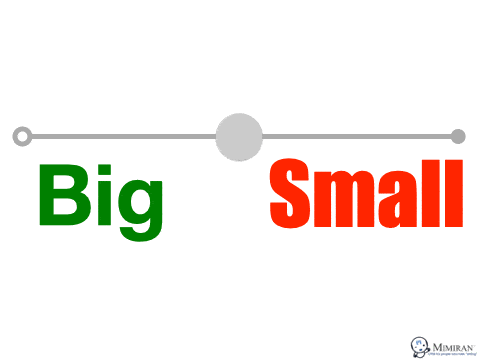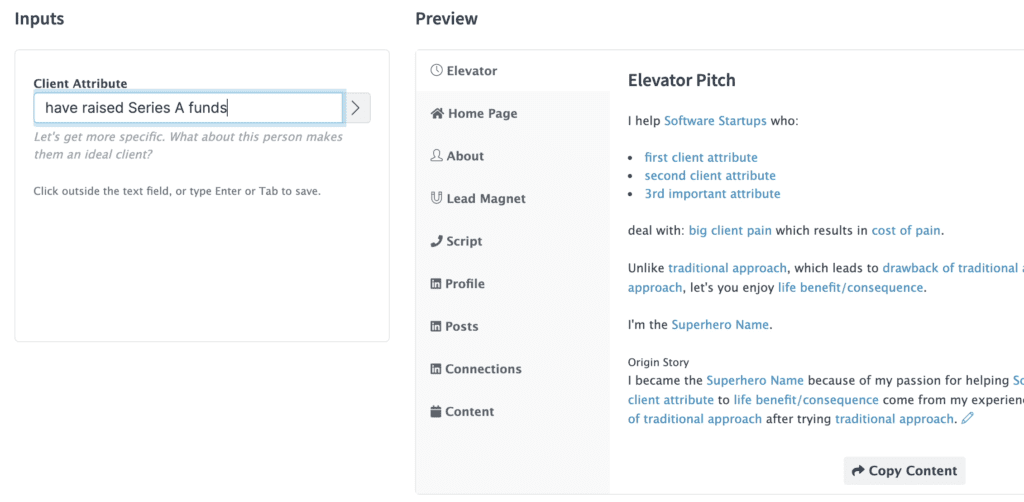If you don’t know who your ideal consulting clients are, how will you work with them?
Not knowing your ideal client profile, and not therefore not being able to position yourself and your services to your ideal client, is the #1 sales and marketing problem for independent consultants.
You feel like you can help so many people, and you don’t want to exclude anyone.
So, in an effort to appeal to everyone, or at least as broad a swath of the market as possible, you end up not appealing to anyone. Marketing feels like a struggle. Sales feels like a struggle. Perhaps worst of all, many projects feel like a struggle. Joy seeps out of your work and your day. And you end up in a vicious cycle.
If you’re going to put all that effort in, why not put it into finding the ideal clients? The ones who are eager to work with you, pay you, and help you help them?
Unless you have completely saturated your ideal market, why not get more ideal clients before trying to get less-than-ideal clients?
Humans seem to have an innate, evolutionary aversion to scarcity, even if that scarcity doesn’t matter. (“Oh no, only 1,000 possible ideal clients! I better pursue this larger market with 1,000,000 prospects!”) Have you served the 1,000 ideal clients yet?
Instead of thinking of a small market vs large market, think of whether you want sales and marketing to be “easy” or “hard”.

If sales and marketing feels too hard, start by going narrower.
How can you define your target market?
Let’s look at some dimensions we can use to subsegment the overall market, and examples of how to use them.
Traditional Market Segmentation
These traditional market segmentation techniques have the advantages of being easy to understand, easy to search for, and easy find in associations, online groups, and the like.
Industry
Good: Manufacturing
Better: Semiconductor manufacturing
Best: Low-power semiconductor manufacturing for space missions
Company Employee Count
Good: Over 10,000
Better: 10,000-20,000
Best: 1,000-2,000 person division of 10,000-20,000 person company
Company Financials
Good: $1B+ in revenue
Better: $1B-2B in revenue
Best: $1B-2B in revenue, raised at least $100M in capital, growing at 25%+ per year, profit at least 5%, but declining
Geography
Bad: I can work with people anywhere
OK: United States
Better: Austin, TX
Best: within a 5 minute drive of my house
Role
Bad: VPs and C-level execs
Good: VPs of Sales
Best: VPs of Sales who just got their first VP role
Other Characteristics
These attributes (and others you may consider) don’t necessarily show up in a LinkedIn search, but they may be just as useful, if not more so, in defining your ideal prospect, and letting that ideal prospect know that they are in the right place when they are on your site.
Generation/Age/Demographics
Note that discrimination based on age, gender, etc is no beuno, but appealing to your ideal prospect’s specific needs is great. (You don’t see ads for blood pressure medicine targeted at young people. Beer commercials, on the other hand…)
Good: Entrepreneurs over 40
Better: Women entrepreneurs over 40
Best: Women entrepreneurs over 40 who want to be present for their kids (just in case you’re wondering, this male entrepreneur over 40 who wants to be present for his kids wasn’t trying to make a statement about gender, unless you happen to have gender attributes for your ideal client profile).
Psychological Profile
Do you notice particular psychological characteristics for your best clients? I hear a lot of consultants say they look for “coachable” clients, which makes sense. It’s not always easy to discover, though. Almost everyone thinks they’re great at taking good advice. 😉
Good: visionaries
Better: risk-takers/risk avoiders
Best: INTJs (note: I’m a Myers-Briggs skeptic, but people who swear by it would think differently).
Other products/technologies
A great way to target clients is if you help them use some other product or service.
Good: Shopify users
Better: Shopify users selling through Facebook
Best: Shopify users selling athleisure clothing through Facebook
Personal Demographics
Do you work best with young people? People about to retire? Do you help people find their footing after a divorce? People with dogs?
You’ve got to be careful with this stuff– always frame it in a positive way (“I love working with my dog at my side”, not “cats are terrible minions of Satan, and their owners do Satan’s bidding”). Note that the good/better/best is not a judgement of the people themselves, but of their fit with you.
Internal Events
Internal events like mergers, acquisitions, IPOs, funding, hiring, new locations, etc, may be great indicators of a good (or bad) fit.
Good: pre-IPO manufacturing company CFOs
Better: pre-IPO manufacturing company CFOs with off-shore manufacturing
Best: pre-IPO manufacturing company CFOs with off-shore manufacturing and exposure to X commodity prices
Seasonal or recurring external events
Some clients may need help for specific times– conferences, seasonal bursts, or other recurring events. These can be great clients who don’t need to hire a full time person to take full advantage of the opportunities you can deliver from these events.
Special external events
Special external events, like getting acquired, being involved with a lawsuit or natural disaster, companies with particular exposure to political events or PR situations may benefit from your help.
Legal/regulatory
Some companies need help with complex regulations, especially in fields like healthcare, financial services, or government contracting. Large companies probably have full-time staff devoted to these issues, but many smaller companies don’t. If you can help these firms, perhaps more effectively than they could ever hope from a full time hire, for much less investment, you can create a strong niche.
Watering Holes
Where do your best clients hang out? This could include:
- Conferences and associations
- Local networking groups or charities
- Online communities. Search on Google and your favorite social networking platforms
- Literal watering holes– sometimes folks still enjoy happy hour
The problem with looking for watering holes if you don’t have a good handle on your ideal client is that you can fall into a rabbit hole of thinking you’re connecting with prospects and partners, when you’re just mingling with other people looking for prospects and partners. Devote a lot of time and energy here once you’ve figured out who to target.
Other attributes
What other attributes seem common among your best clients?
Combining attributes
The real magic comes when you combine these attributes. For example, your ideal client might be a new VP of Sales for a mobile device semiconductor manufacturing company who has an engineering background.
This is why Mimiran’s Mission & Positioning screen asks you to define 3 attributes for your ideal client. You can make each of them as targeted as you want.

Based on your responses, Mimiran provides an outline for an elevator pitch, your home page, lead magnets, your LinkedIn profile, and more.
If you want to your positioning to do the heavy lifting for you, log into your Mimiran account. If you don’t have a Mimiran account, sign up for free.
And if you’d like some help, join an “office half-hour” on May 17 at 11:30CT and you’ll see how stronger positioning makes sales and marketing easier, more effective, and much more fun.
